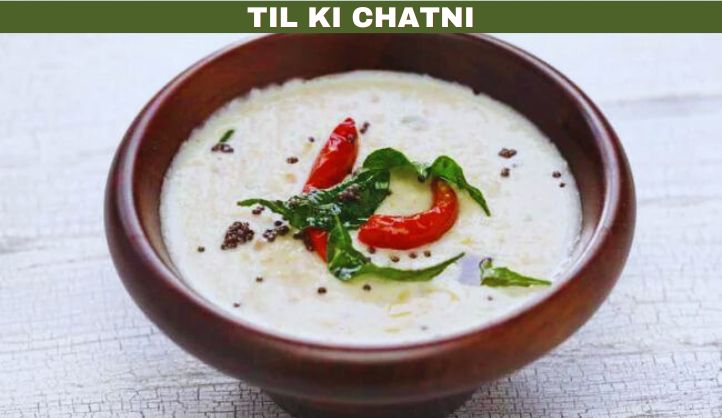In the diverse tapestry of Indian cuisine, certain dishes stand out not only for their delightful flavors but also for their cultural significance. Til ki Chatni, or sesame seed chutney, is one such gem. With its earthy aroma, nutty taste, and versatility, this traditional condiment has been gracing tables across India for centuries. Join me on a flavorful journey as we uncover the secrets of Til ki Chatni and explore its place in the culinary landscape.
The Essence of Til ki Chatni
Til ki Chatni is a classic Indian condiment made from sesame seeds, also known as til. These tiny seeds are rich in flavor and nutrition, making them a popular choice in Indian cooking. The chutney itself is a harmonious blend of sesame seeds, spices, and tangy ingredients, resulting in a sauce that’s both savory and slightly sweet, with a hint of heat.
Ingredients
The beauty of Til ki Chatni lies in its simplicity, with just a handful of ingredients coming together to create a burst of flavor. Here’s what you’ll typically find in this delectable chutney
1. Sesame Seeds (Til) – The star ingredient, sesame seeds, are toasted to bring out their nutty flavor and then ground to a coarse or fine paste, depending on personal preference.
2. Jaggery or Sugar – To balance the nuttiness of the sesame seeds, jaggery or sugar is added to impart a subtle sweetness to the chutney.
3. Tamarind – Tamarind pulp adds a tangy kick to the chutney, balancing the sweetness of the jaggery and enhancing the overall flavor profile.
4. Spices – Common spices include red chili powder, cumin seeds, and salt, each adding depth and complexity to the chutney.
5. Oil – A small amount of oil is used for tempering the spices and adding richness to the chutney.
6. Water – Water is added as needed to achieve the desired consistency of the chutney.
Preparation Method
The preparation of Til ki Chatni is relatively simple, with just a few steps standing between you and a flavorful condiment. Here’s a basic outline of the cooking process
1. Dry roast the sesame seeds in a pan until they turn golden brown and release their aroma. Be sure to stir them continuously to prevent burning.
2. Allow the roasted sesame seeds to cool, then grind them into a coarse or fine powder using a spice grinder or mortar and pestle.
3. In a separate pan, heat a small amount of oil and add cumin seeds. Once the cumin seeds crackle, add red chili powder and sauté briefly.
4. Add tamarind pulp, jaggery or sugar, salt, and water to the pan, stirring well to combine.
5. Bring the mixture to a gentle simmer, then add the ground sesame seeds and mix thoroughly.
6. cook the chutney until it thickens slightly and reaches the desired consistency. Adjust the seasoning to taste, adding more salt or sugar if necessary.
7. Once cooked, remove the chutney from the heat and allow it to cool before serving.
Pairing and Serving
Til ki Chatni is incredibly versatile and pairs well with various Indian dishes. Here are some delicious serving suggestions
– Serve Til ki Chatni as a dipping sauce or condiment alongside snacks like samosas, pakoras, or dhoklas.
– Drizzle Til ki Chatni over chaats, salads, or roasted vegetables for an extra flavor.
– Use Til ki Chatni as a marinade or glaze for grilled meats, tofu, or paneer.
– Spread Til ki Chatni on sandwiches or wraps for a unique twist on traditional fillings.
– Enjoy Til ki Chatni as a side dish with rice, dal, or roti for a complete meal experience.
Cultural Significance
Beyond its tantalizing flavors, Til ki Chatni holds cultural significance in Indian cuisine. It is often prepared during festivals and special occasions, symbolizing prosperity, abundance, and good fortune. In many Indian households, it’s believed that consuming sesame seeds during festivals brings blessings and prosperity for the year ahead. As such, Til ki Chatni is a cherished part of festive celebrations, enjoyed by family and friends alike.
Exploring Variations and Innovations
While the classic recipe for Til ki Chatni holds its charm, there are numerous variations and innovative twists that can be explored to tailor the chutney to individual tastes and preferences. Here are some exciting variations to consider:
1. Sesame-Coconut Chutney
Blend toasted sesame seeds with freshly grated coconut, green chilies, ginger, and a splash of lemon juice for a vibrant and tropical twist on Til ki Chatni. This variation adds a refreshing flavor and creamy texture to the chutney, perfect for pairing with South Indian dishes like dosas and idlis.
2. Spicy Peanut Sesame Chutney
Combine roasted peanuts with toasted sesame seeds, garlic, red chili powder, and a dash of vinegar for a zesty and fiery version of Til ki Chatni. This bold and flavorful variation is ideal for those who enjoy a bit of heat in their condiments and pairs well with grilled meats, kebabs, and sandwiches.
3. Sweet and Sour Til ki Chatni
Balance the nuttiness of sesame seeds with the sweetness of dates and the tanginess of tamarind for a delightful sweet and sour variation of Til ki Chatni. This rich and indulgent chutney is a perfect accompaniment to festive dishes like puris, kachoris, and festive rice preparations.
4. Sesame-Ginger Chutney
Infuse Til ki Chatni with the warm and aromatic flavors of fresh ginger, green chilies, and lemon juice for a zingy and invigorating variation. This bright and zesty chutney adds a refreshing kick to grilled vegetables, salads, and wraps, making it an ideal choice for light and healthy meals.
5. Creamy Sesame Yogurt Dip
Blend toasted sesame seeds with creamy yogurt, garlic, mint, and a pinch of cumin for a smooth and velvety dip that’s perfect for dunking vegetables, chips, and crackers. This cooling and refreshing variation of Til ki Chatni is a great addition to summer picnics, barbecues, and gatherings.
6. Sesame-Honey Drizzle
Combine toasted sesame seeds with raw honey, cinnamon, and a splash of apple cider vinegar for a sweet and aromatic drizzle that’s perfect for topping pancakes, waffles, oatmeal, and desserts. This indulgent variation of Til ki Chatni adds a touch of luxury to breakfast and dessert offerings, making them truly irresistible.
Other Famous Dishes of Uttarakhand
1. Phaanu
Phaanu is a nutritious and hearty lentil curry made from soaked and ground mixed lentils, such as whole urad dal (black gram) and rajma (kidney beans). The lentils are slow-cooked with spices like cumin, coriander, and asafoetida until they form a thick, creamy consistency. Phaanu is often served with steamed rice or roti and is a popular dish in the Garhwal region of Uttarakhand.
2. Bhang Ki Chutney
Bhang Ki Chutney is a traditional condiment made from bhang seeds, which are also known as hemp seeds. The seeds are ground and mixed with garlic, green chilies, and spices to create a tangy and flavorful chutney. Bhang Ki Chutney is typically served with snacks, parathas, or as a side dish with meals in Uttarakhand.
3. Dubuk
Dubuk is a savory porridge-like dish made from coarse wheat flour, water, and spices. It is cooked to a thick consistency and often flavored with ghee, garlic, and cumin seeds. Dubuk is a comforting and filling meal, especially during cold winter months, and is commonly enjoyed in the Kumaon region of Uttarakhand.
4. Arsa
Arsa is a traditional sweet delicacy made from soaked rice, jaggery (or sugar), and ghee. The ingredients are mixed together to form a dough, which is then shaped into small round balls and deep-fried until golden brown. Arsa has a crispy exterior and a soft, chewy interior, making it a popular sweet treat during festivals and special occasions in Uttarakhand.
Bhatt Ki Churkani
Bhatt Ki Churkani is a flavorful curry made from black soybeans (bhatt) cooked in a rich and spicy gravy. The dish is seasoned with local spices and sometimes includes vegetables like potatoes or spinach. Bhatt Ki Churdkani is often served with rice or roti for a hearty meal.
Kumauni Raita
Kumauni Raita is a cooling yogurt-based side dish seasoned with mustard seeds, curry leaves, and green chilies. It may also contain grated cucumber or carrots for added freshness. Kumaoni Raita complements spicy dishes and is a common accompaniment in Uttarakhand cuisine.
In Conclusion
Til ki Chatni is more than just a condiment; it’s a culinary treasure that embodies the rich tapestry of Indian cuisine. With its nutty flavor, subtle sweetness, and tangy undertones, it adds depth and complexity to a wide range of dishes, elevating the dining experience with each spoonful. Whether enjoyed during festive celebrations or as a daily indulgence, Til ki Chatni invites us to savor the simple pleasures of life and revel in the magic of flavors that bring us together.
FAQs About Til ki Chatni
1. What is Til ki Chatni?
Til ki Chatni is a traditional Indian condiment made from sesame seeds (til). It is a savory-sweet chutney with a nutty flavor and a hint of tanginess, often served as a dip or accompaniment to snacks, meals, or festive dishes.
2. What are the main ingredients used in Til ki Chatni?
The main ingredients in Til ki Chatni include sesame seeds (til), jaggery or sugar for sweetness, tamarind pulp for tanginess, spices like red chili powder, cumin seeds, salt, and water to adjust the consistency. Some variations may include additional ingredients like garlic, ginger, or coconut for added flavor.
3. How is Til ki Chatni prepared?
Til ki Chatni is prepared by dry-roasting sesame seeds until golden brown, then grinding them into a coarse paste. The paste is then mixed with jaggery or sugar, tamarind pulp, spices, and water to achieve the desired consistency. The chutney may be tempered with spices like cumin seeds and red chili powder in hot oil for added flavor.
4. What are the different ways to serve Til ki Chatni?
Til ki Chatni can be served in various ways, including as a dip for snacks like samosas, pakoras, or dhoklas, as a spread for sandwiches or wraps, or as a side dish with meals such as roti, paratha, or rice dishes. It can also be used as a marinade or glaze for grilled meats or vegetables.
5. Is Til ki Chatni suitable for vegetarians and vegans?
Yes, Til ki Chatni is suitable for vegetarians as it does not contain any meat or animal-derived ingredients. However, it may not be suitable for vegans if it contains jaggery, which is often used as a sweetener and may be processed using bone char.
6. How long does Til ki Chatni last?
Til ki Chatni can be stored in an airtight container in the refrigerator for up to 1-2 weeks. It is best consumed fresh for optimal flavor and texture.





